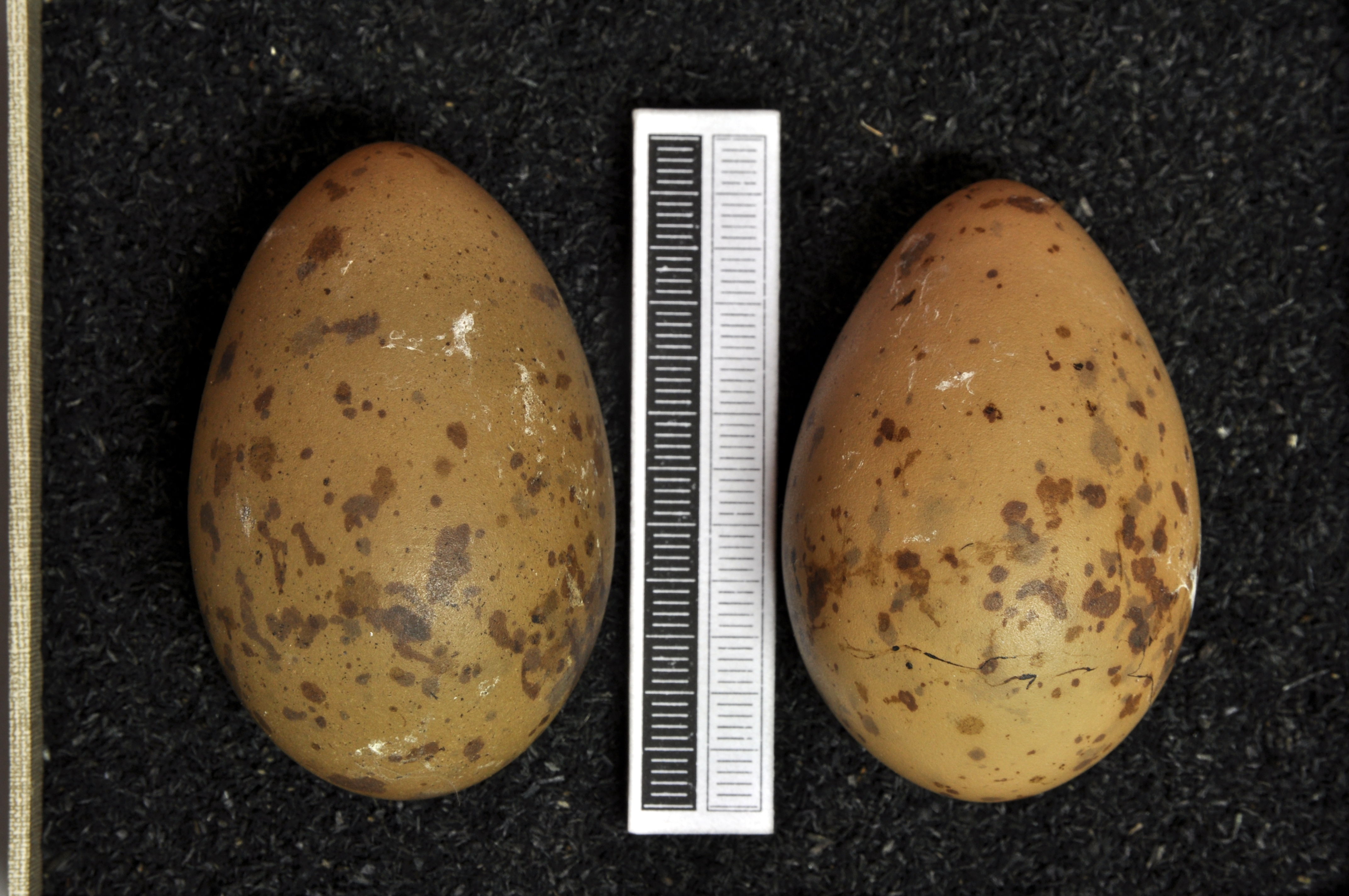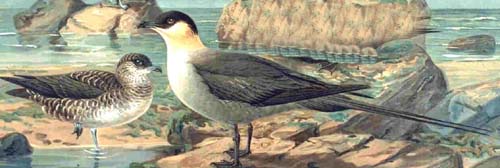Long-tailed skua on:
[Wikipedia]
[Google]
[Amazon]
The long-tailed skua or long-tailed jaeger (''Stercorarius longicaudus'') is a

 This species is unmistakable as an adult, with grey back, dark primary wing feathers without a white "flash", black cap and very long tail. Adults often hover over their breeding territories. Juveniles are much more problematic, and are difficult to separate from parasitic jaeger over the sea. They are slimmer, longer-winged and more tern-like than that species, but show the same wide range of plumage variation. However, they are usually colder toned than Arctic, with greyer shades, rather than brown.
This is the smallest of the skua family at , depending on season and age. However up to of its length can be made up by the tail which may include the tail streamers of the summer adult. The wingspan of this species ranges from and the body mass is .
This species is unmistakable as an adult, with grey back, dark primary wing feathers without a white "flash", black cap and very long tail. Adults often hover over their breeding territories. Juveniles are much more problematic, and are difficult to separate from parasitic jaeger over the sea. They are slimmer, longer-winged and more tern-like than that species, but show the same wide range of plumage variation. However, they are usually colder toned than Arctic, with greyer shades, rather than brown.
This is the smallest of the skua family at , depending on season and age. However up to of its length can be made up by the tail which may include the tail streamers of the summer adult. The wingspan of this species ranges from and the body mass is .
 This species breeds in the high Arctic of
This species breeds in the high Arctic of
Long-tailed jaeger photos
a
Oiseaux.net
* * * * * * * {{Taxonbar, from=Q216921
seabird
Seabirds (also known as marine birds) are birds that are adapted to life within the marine environment. While seabirds vary greatly in lifestyle, behaviour and physiology, they often exhibit striking convergent evolution, as the same enviro ...
in the skua
The skuas are a group of predatory seabirds with seven species forming the genus ''Stercorarius'', the only genus in the family Stercorariidae. The three smaller skuas, the long-tailed skua, the Arctic skua, and the pomarine skua are called ...
family Stercorariidae.
Etymology
The word "jaeger" is derived from theGerman
German(s) may refer to:
* Germany (of or related to)
** Germania (historical use)
* Germans, citizens of Germany, people of German ancestry, or native speakers of the German language
** For citizens of Germany, see also German nationality law
**Ge ...
word ''Jäger'', meaning "hunter". The English word "skua" comes from the Faroese name ''skúgvur'' for the great skua, with the island of Skúvoy known for its colony of that bird. The general Faroese term for skuas is ''kjógvi'' . The genus name ''Stercorarius'' is Latin
Latin (, or , ) is a classical language belonging to the Italic branch of the Indo-European languages. Latin was originally a dialect spoken in the lower Tiber area (then known as Latium) around present-day Rome, but through the power of the ...
and means "of dung"; the food disgorged by other birds when pursued by skuas was once thought to be excrement. The specific ''longicaudus'' is from Latin
Latin (, or , ) is a classical language belonging to the Italic branch of the Indo-European languages. Latin was originally a dialect spoken in the lower Tiber area (then known as Latium) around present-day Rome, but through the power of the ...
''longus'', "long", and ''cauda'', "tail".
Description
 This species is unmistakable as an adult, with grey back, dark primary wing feathers without a white "flash", black cap and very long tail. Adults often hover over their breeding territories. Juveniles are much more problematic, and are difficult to separate from parasitic jaeger over the sea. They are slimmer, longer-winged and more tern-like than that species, but show the same wide range of plumage variation. However, they are usually colder toned than Arctic, with greyer shades, rather than brown.
This is the smallest of the skua family at , depending on season and age. However up to of its length can be made up by the tail which may include the tail streamers of the summer adult. The wingspan of this species ranges from and the body mass is .
This species is unmistakable as an adult, with grey back, dark primary wing feathers without a white "flash", black cap and very long tail. Adults often hover over their breeding territories. Juveniles are much more problematic, and are difficult to separate from parasitic jaeger over the sea. They are slimmer, longer-winged and more tern-like than that species, but show the same wide range of plumage variation. However, they are usually colder toned than Arctic, with greyer shades, rather than brown.
This is the smallest of the skua family at , depending on season and age. However up to of its length can be made up by the tail which may include the tail streamers of the summer adult. The wingspan of this species ranges from and the body mass is .
Subspecies
Two subspecies are described: * ''S. l. longicaudus'' –Vieillot
Louis Pierre Vieillot (10 May 1748, Yvetot – 24 August 1830, Sotteville-lès-Rouen) was a French ornithologist.
Vieillot is the author of the first scientific descriptions and Linnaean names of a number of birds, including species he collect ...
, 1819: nominate
Nomination is part of the process of selecting a candidate for either election to a public office, or the bestowing of an honor or award. A collection of nominees narrowed from the full list of candidates is a short list.
Political office
In the ...
, found in northern Scandinavia
Scandinavia; Sámi languages: /. ( ) is a subregion in Northern Europe, with strong historical, cultural, and linguistic ties between its constituent peoples. In English usage, ''Scandinavia'' most commonly refers to Denmark, Norway, and Swe ...
and Russia
Russia (, , ), or the Russian Federation, is a transcontinental country spanning Eastern Europe and Northern Asia. It is the largest country in the world, with its internationally recognised territory covering , and encompassing one-eig ...
.
* ''S. l. pallescens'' – Løppenthin, 1932: found in eastern Siberia
Siberia ( ; rus, Сибирь, r=Sibir', p=sʲɪˈbʲirʲ, a=Ru-Сибирь.ogg) is an extensive region, geographical region, constituting all of North Asia, from the Ural Mountains in the west to the Pacific Ocean in the east. It has been a ...
, Arctic North America, and Greenland
Greenland ( kl, Kalaallit Nunaat, ; da, Grønland, ) is an island country in North America that is part of the Kingdom of Denmark. It is located between the Arctic and Atlantic oceans, east of the Canadian Arctic Archipelago. Greenland i ...
.
Breeding
 This species breeds in the high Arctic of
This species breeds in the high Arctic of Eurasia
Eurasia (, ) is the largest continental area on Earth, comprising all of Europe and Asia. Primarily in the Northern and Eastern Hemispheres, it spans from the British Isles and the Iberian Peninsula in the west to the Japanese archipelago ...
and North America, with major populations in Russia
Russia (, , ), or the Russian Federation, is a transcontinental country spanning Eastern Europe and Northern Asia. It is the largest country in the world, with its internationally recognised territory covering , and encompassing one-eig ...
, Alaska
Alaska ( ; russian: Аляска, Alyaska; ale, Alax̂sxax̂; ; ems, Alas'kaaq; Yup'ik: ''Alaskaq''; tli, Anáaski) is a state located in the Western United States on the northwest extremity of North America. A semi-exclave of the U.S. ...
and Canada
Canada is a country in North America. Its ten provinces and three territories extend from the Atlantic Ocean to the Pacific Ocean and northward into the Arctic Ocean, covering over , making it the world's second-largest country by tot ...
and smaller populations around the rest of the Arctic
The Arctic ( or ) is a polar region located at the northernmost part of Earth. The Arctic consists of the Arctic Ocean, adjacent seas, and parts of Canada (Yukon, Northwest Territories, Nunavut), Danish Realm (Greenland), Finland, Iceland, N ...
. It is a migrant, wintering in the south Atlantic
The Atlantic Ocean is the second-largest of the world's five oceans, with an area of about . It covers approximately 20% of Earth's surface and about 29% of its water surface area. It is known to separate the " Old World" of Africa, Europe an ...
and Pacific
The Pacific Ocean is the largest and deepest of Earth's five oceanic divisions. It extends from the Arctic Ocean in the north to the Southern Ocean (or, depending on definition, to Antarctica) in the south, and is bounded by the contine ...
. Passage juvenile birds sometimes hunt small prey in ploughed fields or golf-courses, and are typically quite fearless of humans.
They nest on dry tundra
In physical geography, tundra () is a type of biome where tree growth is hindered by frigid temperatures and short growing seasons. The term ''tundra'' comes through Russian (') from the Kildin Sámi word (') meaning "uplands", "treeless mou ...
or higher fells laying two spotted olive-brown eggs. On the breeding grounds they can be heard making yelping and rattling sounds. Outside of the breeding season they spend most of their time over open ocean and have a harsh ''kreeah'' cry. This bird feeds on fish (mainly caught from other seabirds), smaller birds, food scraps, small mammals, fruit and carrion. On migration, long-tailed jaegers are more likely to catch their own food, and less likely to steal from gull
Gulls, or colloquially seagulls, are seabirds of the family Laridae in the suborder Lari. They are most closely related to the terns and skimmers and only distantly related to auks, and even more distantly to waders. Until the 21st century ...
s and tern
Terns are seabirds in the family Laridae that have a worldwide distribution and are normally found near the sea, rivers, or wetlands. Terns are treated as a subgroup of the family Laridae which includes gulls and skimmers and consists of e ...
s than larger species
In biology, a species is the basic unit of classification and a taxonomic rank of an organism, as well as a unit of biodiversity. A species is often defined as the largest group of organisms in which any two individuals of the appropriate s ...
.
References
External links
Long-tailed jaeger photos
a
Oiseaux.net
* * * * * * * {{Taxonbar, from=Q216921
long-tailed jaeger
The long-tailed skua or long-tailed jaeger (''Stercorarius longicaudus'') is a seabird in the skua family Stercorariidae.
Etymology
The word "jaeger" is derived from the German word ''Jäger'', meaning "hunter". The English word "skua" comes fr ...
Birds of the Arctic
Holarctic birds
long-tailed jaeger
The long-tailed skua or long-tailed jaeger (''Stercorarius longicaudus'') is a seabird in the skua family Stercorariidae.
Etymology
The word "jaeger" is derived from the German word ''Jäger'', meaning "hunter". The English word "skua" comes fr ...
long-tailed jaeger
The long-tailed skua or long-tailed jaeger (''Stercorarius longicaudus'') is a seabird in the skua family Stercorariidae.
Etymology
The word "jaeger" is derived from the German word ''Jäger'', meaning "hunter". The English word "skua" comes fr ...